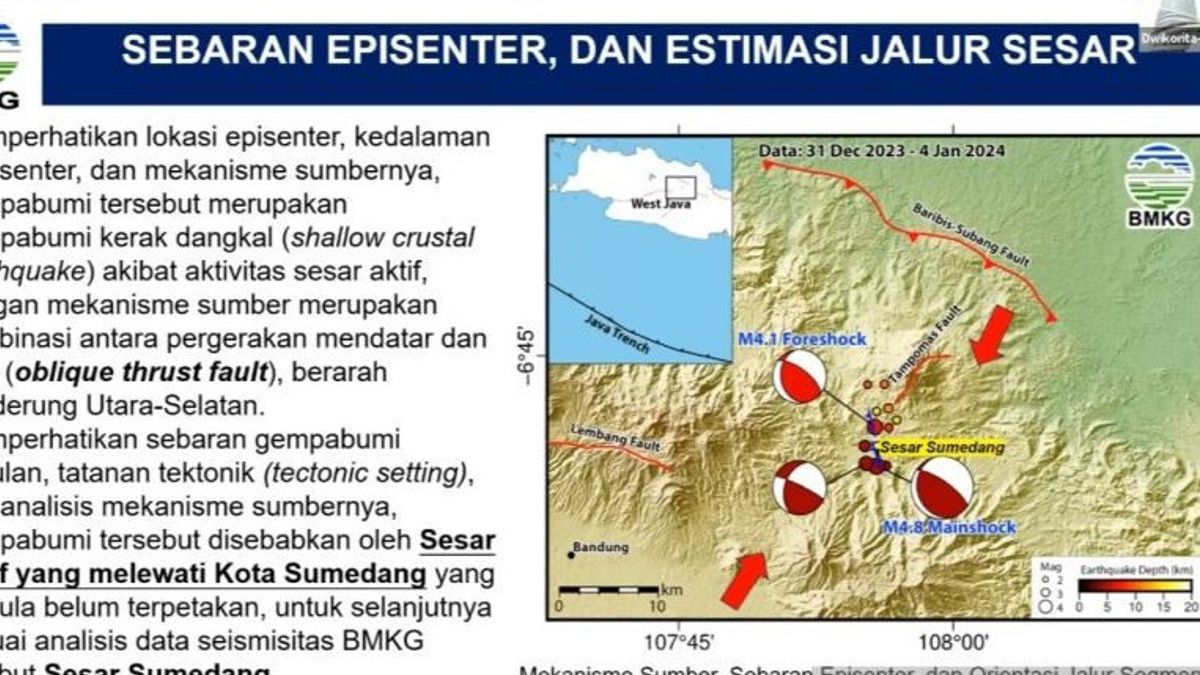
JAKARTA - The Meteorology, Climatology and Geophysics Agency (BMKG) identified a new fault that caused the 4.8 magnitude (M) earthquake that occurred on December 31, 2023.
"Paying attention to the distribution of aftershocks, tectonic order, and analysis of the source mechanism, the earthquake was caused by an active fault passing through Sumedang City which had not previously been mapped according to the analysis of BMKG seismicity data, so it was called the Sumedang Fault," said Head of BMKG Dwikorita Karnawati at a press conference in Jakarta, Monday, January 8, quoted by Antara.
Dwikorita said that BMKG has conducted seismicity surveys, macroseismic surveys, microzone surveys, deformation surveys, air shoots with lidar, morphotectonic evaluations, and surveys of subsurface fault structures to map the main cause of the earthquake.
"The surveys are carried out to map the activity and distribution of earthquakes and to know in detail the main causes of the earthquake, including identifying and validating the fault path," he said.
He said that Sumedang Regency is an area prone to earthquakes with earthquake sources from the collision zone of the Indo-Australian and Eurasian Plates in the Indian Ocean.
In addition, he continued, there are active faults on the mainland that have been mapped, such as the Cimandiri Fault, Cugenang Fault, Lembang Fault, Cipamingkis Fault, Garsela Fault, Baribis Fault, Cicalengka Fault, Cileunyi-Tanjungsari Fault, Tomo Fault, and Cipeles Fault as well as several inactive faults that have not been mapped that can trigger earthquakes in the area.
Based on the Earthquake Catalog that damaged BMKG from 2020, said Dwikorita, Sumedang area on August 14, 1955 experienced an earthquake that caused damage to many buildings and on December 19, 1972 faced an earthquake with a magnitude of 4.5 which resulted in damage to buildings and landslides.
"The earthquake that occurred on December 31, 2023 was not only felt in Sumedang Regency and Bandung Regency, but also felt in Bandung City, Sumedang Regency, to Garut Regency," he said.
관련 항목:
As part of mitigation efforts, BMKG together with the Sumedang Regency Government, the National Disaster Management Agency (BNPB), the Search and Rescue Office, and the Ministry of Social Affairs synergize to increase public literacy regarding seismicity, including mitigation and rescue measures that must be carried out before, at the time, and after the earthquake.
Dwikorita said that BMKG had submitted several recommendations for mitigation efforts to local governments and related agencies.
The recommendations referred to include evaluating the plan for spatial planning and the Sumedang Regency area by considering the map of the earthquake hazard zone and the deployment of active faults (Sumedang Faults).
In addition, BMKG conveyed the results of the evaluation and application of standard earthquake-resistant building rules based on the Peak Ground Acceleration (PGA)-based micro-zone map as well as recommendations for sustainable disaster education and socialization programs.
BMKG also conveyed the importance of keeping the community from being easily influenced by issues whose sources are not clear.
The English, Chinese, Japanese, Arabic, and French versions are automatically generated by the AI. So there may still be inaccuracies in translating, please always see Indonesian as our main language. (system supported by DigitalSiber.id)















